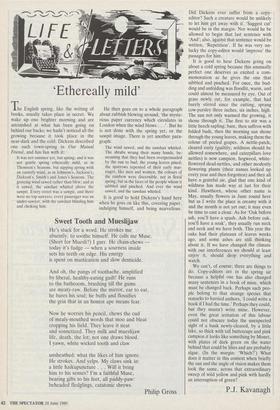`Ethereally mild'
The English spring, like the writing of books, usually takes place in secret. We wake up one brighter morning and are astonished at what has been going on behind our backs; we hadn't noticed all the growing because it took place in the near-dark and the cold. Dickens described one such town-spring in Our Mutual Friend, and has fun with it: It was not summer yet, but spring; and it was not gentle spring ethereally mild, as in Thomson's Seasons, but nipping spring with an easterly wind, as in Johnson's, Jackson's, Dickson's, Smith's and Jones's Seasons. The grateing wind sawed rather than blew; and as it sawed, the sawdust whirled above the sawpit. Every street was a sawpit, and there were no top-sawyers; every passenger was an under-sawyer, with the sawdust blinding him and choking him.
He then goes on to a whole paragraph about rubbish blowing around, 'the myste- rious paper currency which circulates in London when the wind blows . . .'. But he is not done with the spring yet, or the sawpit image. There is yet another para- graph:
The wind sawed, and the sawdust whirled. The shrubs wrung their many hands, be- moaning that they had been overpersuaded by the sun to bud; the young leaves pined; the sparrows repented of their early mar- riages, like men and women; the colours of the rainbow were discernible, not in floral spring, but in the faces of the people whom it nibbled and pinched. And ever the wind sawed, and the sawdust whirled.
It is good to hold Dickens's hand here when he goes on like this, covering paper, indulging himself, and being marvellous. Did Dickens ever suffer from a copy- editor? Such a creature would be unlikely to let him get away with it. 'Suggest cut' would be in the margin. Nor would he be allowed to begin that last sentence with `And'; also, against that sentence would be written, 'Repetition'. If he was very un- lucky the copy-editor would 'improve' the passages for him.
It is good to hear Dickens going on about a cold spring because this unusually perfect one deserves as excited a com- memoration as he gives the one that nibbled and pinched. For once, the bud- ding and unfolding was floodlit, warm, and could almost be measured by eye. Out of grass newly cut, for example, that had barely stirred since the cutting, sprang cow-parsley three inches, six inches, high. The sun not only warmed the growing, it shone through it. The first to stir was a little beech sapling; bare, then saffron with folded buds, then the morning sun shone through the young leaves, making them the colour of peeled grapes. A nettle-patch, cleared early (guiltily; wildness should be allowed somewhere, and caterpillars love nettles) is now campion, hogweed, white- flowered dead-nettles, and other modestly flowering plants (their names looked up every year and then forgotten) and they all have a grateful air, glad that one kind of wildness has made way at last for their kind. Hawthorn, whose other name is May, usually flowers in June round here but as I write the place is creamy with it and the month is not yet out; it may even be time to cast a clout. As for 'Oak before ash, you'll have a spash. Ash before oak, you'll have a soak', they usually run neck and neck and we have both. This year the oaks had their plateaux of leaves weeks ago, and some ashes are still thinking about it. If we have changed the climate with our interferences we should at least enjoy it, should drop everything and watch.
We can't, of course; there are things to do. Copy-editors are in the spring air because a helpful one has also changed many sentences in a book of mine, which must be changed back. Perhaps such peo- ple belong to that strange species that remarks to harried authors, 'I could write a book if I had the time.' Perhaps they could, but they mustn't write mine. However, even the great irritation of this labour could not obscure today the unexpected sight of a bank newly-cleared, by a little lake, so thick with tall buttercups and pink campion it looks like something by Monet, with plates of dark green on the water behind that could be lilies and are probably algae. (In the margin: 'Which?) What does it matter in this context when briefly the sun and the angle of vision makes them look the same, across that extraordinary sweep of wild yellow and pink with hardly an interruption of green?
P.J. Kavanagh


























































 Previous page
Previous page